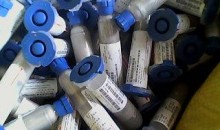PRODUCT DESCRIPTION
FP4323 provides the following product characteristics:
Technology Epoxy
Appearance (Part A) Black
Appearance (Part B) Cream
Appearance (Mixed) Black
Product Benefits • Low CTE for improved thermal cycling
• High purity
• Thixotropic
• Excellent moisture resistance
• Excellent chemical resistance
Filler Weight, % 65
Filler Type Silica
Mix Ratio, by weight – Part
A: Part B
100 : 100
Cure Heat cure
Application Encapsulant – glob top
Typical Assembly
Applications
Chip-on-board and Plastic PGA
applications
Substrates Plastic
FP4323 liquid epoxy encapsulant glob top is designed with flow capabilities that allows encapsulation without flowing beyond the chip.
TYPICAL PROPERTIES OF UNCURED MATERIAL
Part A Properties
Viscosity, Brookfield – RVF, 25 °C, mPa·s (cP):
Spindle 7, speed 2 rpm 172,500
Spindle 7, speed 20 rpm 115,000
Specific Gravity @ 25 °C 1.7
Shelf Life @ 25°C, months 12
Flash Point – See MSDS
Part B Properties
Viscosity, Brookfield – RVF, 25 °C, mPa·s (cP):
Spindle 7, speed 2 rpm 250,000
Spindle 7, speed 20 rpm 72,500
Specific Gravity @ 25 °C 1.7
Shelf Life @ 25°C, months 12
Flash Point – See MSDS
Mixed Properties
Mixed Viscosity, Brookfield – RVF, 25 °C, mPa·s (cP):
Spindle 7, speed 2 rpm 220,000
Spindle 7, speed 20 rpm 100,000
Specific Gravity @ 25 °C 1.67
Gel Time @ 121ºC, minutes 11
Pot Life @ 25 °C, days 2
Shelf Life @ -40 °C, months 9
Working Life@ 25 °C, hours 48
Flash Point – See MSDS
TYPICAL CURING PERFORMANCE
Recommended Cure Schedule
4 hours @ 150°C or
1 hour @ 170°C
Alternative Cure Schedule
2 hours @ 125°C + 4 hours @ 150°C
Substrate Temperature
Temperature, °C 90
The above cure profiles are guideline recommendations. Cure conditions (time and temperature) may vary based on customers’ experience and their application requirements, as well as customer curing equipment, oven loading and actual oven temperatures.
A two-step cure will minimize stress.
TYPICAL PROPERTIES OF CURED MATERIAL
Physical Properties:
Coefficient of Thermal Expansion ASTM D-3386, ppm/°C:
Below Tg (40 to 120°C) 28
Glass Transition Temperature (Tg) by TMA, °C 174
Thermal Conductivity, W/mk 0.63
Shore Hardness, ISO 868, Durometer D 97
Linear Shrinkage, % 0.43
Extractable Ionic Content, ppm:
Chloride (Cl-) 20
Sodium (Na+) 20
Potassium (K+) 20
Water Absorption, ISO 62 , %:
8 hours @ 100°C 0.25
Electrical Properties:
Dielectric Constant / Dissipation Factor, IEC 60250:
1kHz 3.7 / 0.004
100-MHz 3.59 / 0.085
1-GHz 3.44 / 0.075
Volume Resistivity, IEC 60093, Ω·cm 6.2×1014
Surface Resistivity, IEC 60093, Ω 1.6×1014
GENERAL INFORMATION
For safe handling information on this product, consult the Material Safety Data Sheet, (MSDS).
This product is not recommended for use in pure oxygen and/or oxygen rich systems and should not be used with chlorine or other strong oxidizing materials.
DIRECTIONS FOR USE
1. For best results, dispense onto substrate warmed to 90°C.
2. FP4323 may settle upon storage. Each container must be thoroughly mixed before combining.
3. Mix Part A and Part B separately for about 5 to 10 minutes on a standard paint shaker to ensure complete dispersion of the filler.
4. Stir with a large spatula to check for lumps.
5. Cold storage will minimize filler settling.
6. Part B may form a crust if exposed to moist air for an extended period of time. Keep in a well sealed container. For best results, do not use Part B which contains this crust caused by moisture contamination.
7. Thorough mechanical mixing of Part A and Part B together is required for best results. Hand mixing alone is not recommended.
Not for product specifications
The technical data contained herein are intended as reference only. Please contact your local quality department for assistance and recommendations on specifications for this product.
Storage
Store product in the unopened container in a dry location. Storage information may be indicated on the product container labeling.
Optimal Storage: -40°C. Storage below -40°C or greater than -40°C can adversely affect product properties.
Material removed from containers may be contaminated during use. Do not return product to the original container. Henkel Corporation cannot assume responsibility for product which has been contaminated or stored under conditions other than those previously indicated. If additional information is required, please contact your local Technical Service Center or Customer Service Representative.
Conversions
(°C x 1.8) + 32 = °F
kV/mm x 25.4 = V/mil
mm / 25.4 = inches
N x 0.225 = lb
N/mm x 5.71 = lb/in
N/mm² x 145 = psi
MPa x 145 = psi
N·m x 8.851 = lb·in
N·m x 0.738 = lb·ft
N·mm x 0.142 = oz·in
mPa·s = cP
Note
The data contained herein are furnished for information only and are believed to be reliable. We cannot assume responsibility for the results obtained by others over whose methods we have no control. It is the user’s responsibility to determine suitability for the user’s purpose of any production methods mentioned herein and to adopt such precautions as may be advisable for the protection of property and of persons against any hazards that may be involved in the handling and use thereof. In light of the foregoing, Henkel Corporation specifically disclaims all warranties expressed or implied, including warranties of merchantability or fitness for a particular purpose, arising from sale or use of Henkel Corporation’s products. Henkel Corporation specifically disclaims any liability for consequential or incidental damages of any kind, including lost profits. The discussion herein of various processes or compositions is not to be interpreted as representation that they are free from domination of patents owned by others or as a license under any Henkel Corporation patents that may cover such processes or compositions. We recommend that each prospective user test his proposed application before repetitive use, using this data as a guide. This product may be covered by one or more United States or foreign patents or patent applications.
华为网盘下载:http://dl.dbank.com/c00ajx5so1
点击下载附件查看:
 Henkel Loctite Hysol FP4323 TDS (68.0 KB, 103 次)
Henkel Loctite Hysol FP4323 TDS (68.0 KB, 103 次)

















《【扒一扒】日本高纯球形硅微粉材料生产商》: 作为一种无机非金属矿物功能性粉体材料,硅微粉广泛应用于电子材料、电工绝缘材料、胶黏剂、特种陶瓷、精密铸造、油漆涂料、油墨、硅橡胶等领域。 目前,世界上只有中国、日本、韩国、美国等少数国家具备硅微粉生产能力... 全文 ?